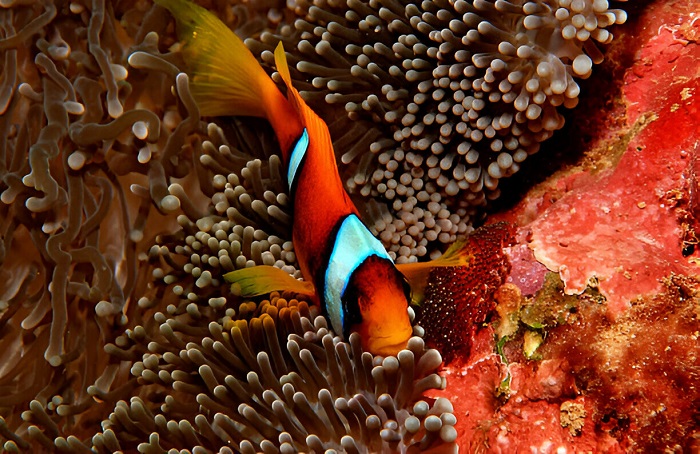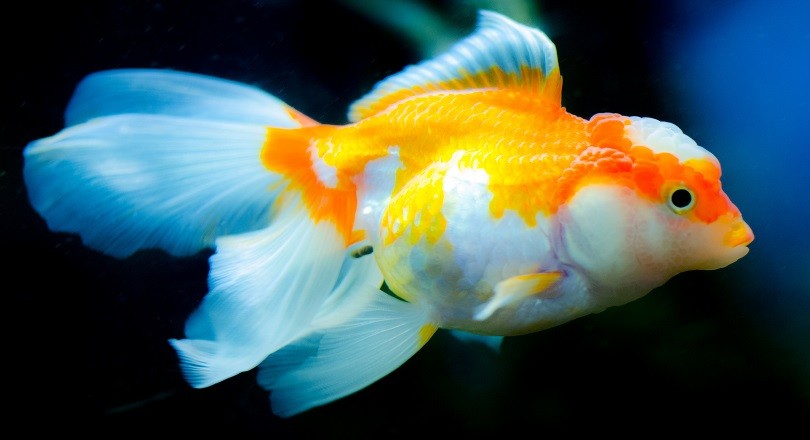Fish can see red light, as they have receptors in their eyes that are sensitive to red wavelengths. Fish have a remarkable visual system that allows them to see a wide range of colors, including red.
Their eyes have special cells called cones that enable them to perceive different colors. These cones are particularly sensitive to longer wavelengths, such as red light. This allows fish to navigate their surroundings and distinguish objects based on color. In fact, red can appear quite vibrant and distinct to many fish species.
Understanding how fish perceive color can be crucial in various contexts, such as designing effective lures for fishing or creating optimal lighting conditions for aquariums. Knowing that fish can see red light opens up a world of possibilities in understanding their visual capabilities and behaviors.
The Vision Of Fish

Evolutionary Adaptation Of Fish Vision
Fish have evolved a remarkable visual system that allows them to navigate and survive in their aquatic environment. Over millions of years, fish have developed specialized adaptations to perceive and interpret visual stimuli. These adaptations have enabled them to detect prey, identify predators, and communicate within their species. Understanding the evolution of fish vision provides valuable insights into their unique visual capabilities.
Anatomy And Physiology Of Fish Eyes
The eyes of fish are intricate organs that play a crucial role in their ability to see. Like human eyes, fish eyes have several key components that contribute to their visual function. The anatomy of fish eyes includes a cornea, lens, iris, and retina. Each of these structures has a specific role in collecting and focusing light, ultimately allowing fish to form images.
Structure Of Fish Eyes
The structure of fish eyes differs from the human eye in some significant ways. Fish eyes lack eyelids, which means they cannot blink to moisten their eyes. To overcome this challenge, fish continuously produce a clear and protective layer of mucus that covers their eyes. This mucus layer helps maintain the clarity of their vision underwater and prevents their eyes from drying out.
Visual Cells In Fish Eyes
Similar to humans, fish have specialized cells that enable them to sense light and color. These cells, known as photoreceptors, are found in the retina of fish eyes. Photoreceptors come in two main types: rods and cones. Rods are responsible for detecting light intensity and aiding in vision under low light conditions. Cones, on the other hand, are vital for color vision and high visual acuity.
Color Perception In Fish
Fish exhibit a wide range of color perception, although it may vary among different species. Many fish can perceive colors across the visible light spectrum, including red, green, and blue. However, their color vision can be different from that of humans. In some cases, fish may have enhanced perception in certain color ranges, while their sensitivity to other colors may be reduced.
Spectral Sensitivity Of Fish
The spectral sensitivity of fish refers to their ability to detect different wavelengths of light. Some fish species have a broader range of spectral sensitivity compared to humans, allowing them to see ultraviolet (UV) light. This ability is particularly useful for tasks like locating food sources or identifying potential mates, as certain objects and patterns reflect UV light.
Rods And Cones In Fish Eyes
The presence of both rods and cones in fish eyes is crucial for their visual acuity. While rods are responsible for low-light vision and detecting motion, cones allow fish to perceive fine details and distinguish colors. The ratio of rods to cones can vary depending on the species and their environment. For example, fish living in deeper waters may have a higher proportion of rods to maximize their ability to see in dim light conditions.
Overall, the vision of fish is a complex and fascinating topic. Their evolutionary adaptations, anatomy, and physiology of their eyes, along with the specialized visual cells, contribute to their unique ability to perceive the underwater world. By understanding how fish see, researchers can gain insights into their behaviors and ecological interactions.
Can Fish See Red Light?
When it comes to the fascinating world of underwater environments, it’s important to understand how different organisms perceive and interact with light. As humans, we often wonder about specific aspects of fish biology and their ability to perceive colors underwater. One burning question that comes to mind is: can fish see red light? Let’s dive deeper into this intriguing topic and explore the fascinating relationship between fish and the color red.
Red Light In Underwater Environments
Underwater environments present unique challenges when it comes to light transmission and perception. Light travels through water differently than air due to various factors such as absorption and scattering. These processes significantly influence the behavior of light in water and ultimately impact how it appears to underwater organisms.
Absorption And Scattering Of Light In Water
Water absorbs and scatters different wavelengths of light to varying degrees. As light penetrates the water, shorter wavelengths, such as blues and greens, are absorbed more readily, causing the underwater environment to appear bluish. On the other hand, longer wavelengths, like reds and oranges, tend to penetrate deeper into the water column.
Changes In Light Spectrum With Depth
The further light travels through water, the more it gets scattered and absorbed. As a result, the light spectrum changes with depth. The deeper you go, the less red and orange light you’ll encounter, as these wavelengths become increasingly attenuated. This phenomenon creates a different color palette and impacts how fish perceive their surroundings.
Perception Of Red Light By Fish
Fish, like many other aquatic organisms, possess specialized photoreceptor cells in their eyes that allow them to perceive and differentiate colors. While the exact capabilities may differ between fish species, they generally have the ability to perceive and respond to red light, albeit with some variations in sensitivity.
Sensitivity To Red Light Wavelengths
Fish exhibit varying sensitivities to different wavelengths of light, including red. Some species are highly sensitive to red light, while others may have limited sensitivity or different visual adaptations. It’s important to consider these factors when studying fish behavior and their response to different light conditions.
Role Of Rods And Cones In Red Light Detection
The eyes of fish are equipped with specialized cells called rods and cones. Rods are responsible for low-light vision, while cones enable color vision. The specific distribution and sensitivity of these cells determine a fish’s ability to detect and perceive red light, as well as other colors.
Red Light And Fish Behavior
Red light can elicit different behaviors and responses in fish. Some studies suggest that certain fish species may be attracted to red light, while others may exhibit a repelling response. The extent and nature of these behaviors may vary depending on species, environmental factors, and individual preferences.
Attraction Or Repulsion Towards Red Light
The attraction or repulsion towards red light in fish is a complex area of research that requires further investigation. While some fish may show a preference for red light, others may avoid it. The reasons behind these behavioral responses are multifaceted and may involve biological, ecological, and evolutionary factors.
Implications For Fishery And Aquaculture
The understanding of fish perception and responses to red light has significant implications for fishery and aquaculture industries. Manipulating lighting conditions or using specific wavelengths of light, including red, may potentially influence fish behavior, feeding patterns, and reproductive processes. This knowledge can be applied to enhance fish habitats, optimize growth and yield in aquaculture settings, and improve overall fish management practices.
Practical Applications And Considerations
Utilizing Red Light In Aquariums And Fish Tanks
Red light has proven to be a valuable tool in enhancing the aesthetics and functionality of aquariums and fish tanks. When utilized effectively, red light provides numerous benefits for both the fish and the aquarist.
- Red light can create a visually appealing ambience, adding a warm and soothing glow to the underwater environment.
- The use of red light can also mimic natural lighting conditions, enabling fish to feel more at ease and comfortable in their surroundings.
- Some species of fish, such as nocturnal or crepuscular varieties, benefit greatly from red light as it aligns with their natural activity patterns and enhances their visibility during low-light periods.
- In addition, red light can promote the growth of beneficial algae and plants within the tank, contributing to a healthy and balanced ecosystem.
Enhancing Fish Visibility And Behavior
Red light has been found to have a positive impact on fish visibility and behavior in various aquatic environments. The unique properties of red light enable fish to perceive their surroundings more clearly and engage in natural behaviors.
- Research suggests that red light allows fish to distinguish colors better, which is particularly beneficial for species that rely on color recognition for communication and mate selection.
- Furthermore, fish exposed to red light tend to exhibit reduced stress levels and increased activity, leading to improved overall well-being.
- For aquarists, the enhanced visibility provided by red light enables easier observation of fish behavior and health, allowing for better monitoring and maintenance of the aquarium.
Effects On Fish Health And Well-being
The use of red light in aquariums and fish tanks has shown promising effects on the health and well-being of aquatic species. Red light therapy has gained attention for its potential healing properties and the ability to alleviate certain health issues in fish.
- Red light is known to stimulate cell regeneration and enhance tissue repair, which can aid in the healing of injuries or wounds on fish.
- Furthermore, exposure to red light has been linked to reduced incidences of stress-related diseases and improved immune system functioning in fish.
- It is important to note that the intensity and duration of red light exposure should be carefully monitored to prevent overstimulation or negative effects on fish health.
Red Light In Sport Fishing
Red light has also found its place in the world of sport fishing, particularly in attracting and luring certain species. Many anglers believe that the use of red light can increase their chances of a successful catch.
- Some fish are highly attracted to red light, as it appears as a vivid contrast in the water and may resemble prey or food sources.
- Red light has been utilized in various fishing techniques, from baiting lures with red colors to the use of underwater red light fixtures to attract fish to a specified area.
- However, it is important to note that the effectiveness of red light in sport fishing may vary depending on the specific species, habitat, and prevailing conditions.
Red Light Attractants And Lure Colors
When it comes to fishing with artificial lures, the choice of colors can significantly impact the success rate. Anglers often experiment with different lure colors, including those with red components, to entice fish.
- Red is a commonly used lure color as it can mimic injured or wounded prey, triggering predatory instincts in fish.
- Red light attractants, such as glow sticks or underwater LED lights emitting red hues, can also be effective in attracting fish to the vicinity of the angler’s bait or lure.
- It is essential to consider the specific preferences and feeding habits of the target fish species when selecting red light attractants or lure colors.
Fish Reaction To Red Light In Different Environments
Fish react differently to red light in various aquatic environments, and their responses can be influenced by their natural habitats and specific adaptations.
- Some species have evolved to be more sensitive to red light, particularly those dwelling in deeper waters where red light penetrates more effectively.
- In contrast, fish inhabiting shallower or heavily vegetated areas may exhibit varying reactions to red light, depending on their exposure and acclimation.
- It is crucial for aquarium owners and anglers alike to research and understand the natural environment of their fish species to effectively utilize red light.
Environmental Impacts Of Red Light Use
While red light can bring numerous advantages to aquariums and sport fishing, its use should be considered in terms of potential environmental impacts.
- Red light can contribute to light pollution, affecting nocturnal wildlife and disrupting natural ecosystems in certain cases.
- It is essential to strike a balance between the benefits of red light usage and its potential ecological consequences, ensuring responsible and mindful application.
Regulations And Conservation Efforts
To mitigate the potential negative effects of red light usage, regulatory measures and conservation efforts are in place to promote sustainable practices.
- Regulations may exist regarding the use of red light in particular fishing areas or protected environments, aiming to minimize disturbance to local ecosystems.
- Conservation organizations and responsible anglers actively participate in initiatives that prioritize the conservation of fish populations and their habitats.
Overall, the practical applications and considerations of red light in relation to fish encompass a wide range of uses, from enhancing aquarium aesthetics and fish behavior to attracting fish in sport fishing. By understanding the effects, benefits, and potential impacts of red light, aquarists and anglers can make informed decisions to optimize their experiences while prioritizing the well-being and conservation of aquatic life.

Credit: www.reddit.com
Frequently Asked Questions For Can Fish See Red Light?
Is A Red Light Good For Fish?
No, a red light is not good for fish. Fish perceive color differently than humans and are sensitive to bright and intense light, including red light. It can cause stress and disrupt their natural behavior and sleeping patterns. Stick to natural lighting or use a dim, low-intensity light for your fish.
Do Fish React To Red Light?
Yes, fish can react to red light. Red light does not disturb their natural behaviors and is often used to simulate nighttime conditions in aquariums.
What Color Light Can Fish Not See?
Fish cannot see the color red.
What Color Light Is Best For Fish?
Blue light is the best for fish. It simulates natural conditions and promotes their overall health.
Can Fish See Red Light?
Fish do have the ability to see red light, but it appears differently to them than it does to humans. While we see red light as one color, fish perceive it as a combination of green and blue light.
Conclusion
To sum it up, fish have the ability to see red light, but their perception of it is different from how humans see it. While we perceive red light as being at the end of the visible light spectrum, fish can see red light as an entirely separate color.
This unique vision allows them to navigate their environments and detect prey efficiently. Understanding the visual capabilities of fish is crucial for those interested in studying their behavior and designing effective aquarium lighting systems.

